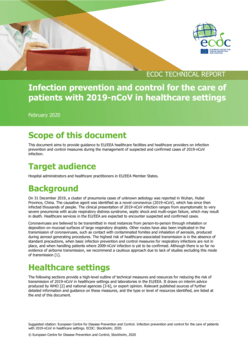Hello! You're looking at a policy document report on Overton
We track government policy, guidelines, think tank research, working papers and more to help our customers see the impact and influence of their work. Are you interested in seeing what information we have to offer? Request a free trial to our platform.
If you fund, produce or manage research or work to influence policy, we'd love to talk. Learn more on our homepage.

Identifiers
Overton ID
ecdc-4e97fc613d0e20d18d50942664e6423f
Infection prevention and control for the care of patients with 2019-nCoV in healthcare settings
This document aims to provide guidance to EU/EEA healthcare facilities and healthcare providers on infection prevention and control measures during the management of suspected and confirmed cases of 2019-nCoV infection.
Topics in this document
Medicine
Medical specialties
Public health
Clinical medicine
Infection control
Epidemiology
Medical humanities
Infectious diseases
Health
Diseases and disorders
Personal protective equipment
Health care
Infection
Transmission (medicine)
Health sciences
Risk assessment
Microbiology
Medical diagnosis
Risk
Patient
Medical statistics
Health economics
Biomedical waste
Related SDGs
SDG 3: Good Health and Well-being ...
SDG 3: Good Health and Well-being
Target 3.3
End the epidemics of AIDS, tuberculosis, malaria and neglected tropical diseases and combat hepatitis, water-borne diseases and other communicable diseases
Target 3.d
Strengthen the capacity of all countries, in particular developing countries, for early warning, risk reduction and management of national and global health risk
Citations
Cited by 64
other policy documents
(51 of them are from other policy sources)
